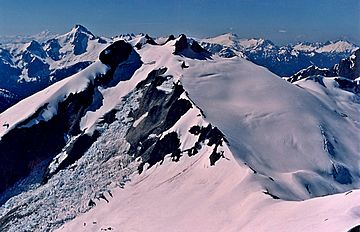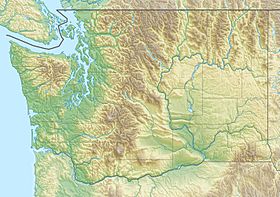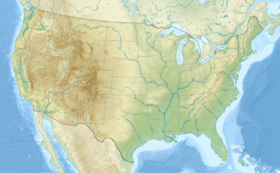Icy Peak facts for kids
Quick facts for kids Icy Peak |
|
|---|---|

Icy Peak seen from Ruth Mountain
|
|
| Highest point | |
| Elevation | 7,073 ft (2,156 m) |
| Prominence | 1,315 ft (401 m) |
| Isolation | 1.54 mi (2.48 km) |
| Parent peak | Seahpo Peak (7,441 ft) |
| Geography | |
| Location | |
| Parent range | North Cascades |
| Topo map | USGS Mount Shuksan |
| Climbing | |
| Easiest route | Climbing, class 4, Glacier travel |
Icy Peak is a tall mountain in Washington state, part of the North Cascades. It stands about 7,073 feet (2,156 meters) high. You can find it inside North Cascades National Park, near a place called Nooksack Cirque.
High ridges connect Icy Peak to other mountains like Seahpo Peak and Mount Shuksan. On its northeast side, there's an icefall, which is like a frozen waterfall. Small glaciers cover all sides of the peak. Water from rain and melting snow flows from the mountain into the Nooksack and Baker Rivers.
Contents
Mountain Weather
Icy Peak is located in a "marine west coast" climate zone. This means its weather is heavily influenced by the nearby Pacific Ocean. Most weather systems come from the Pacific and move northeast towards the Cascade Range.
How Mountains Affect Weather
When these weather systems hit the North Cascades, the mountains force the air to rise. As the air goes higher, it cools down and drops its moisture as rain or snow. This process is called orographic lift. Because of this, the western side of the North Cascades gets a lot of rain and snow, especially in winter.
Seasonal Weather
During winter, the weather is usually cloudy. However, in summer, high-pressure systems over the Pacific Ocean often bring clear skies. The ocean's influence also means the snow tends to be wet and heavy, which can increase the risk of avalanches. The best time to visit or climb Icy Peak is usually from July through September, when the weather is most favorable.
Mountain Formation
The North Cascades region has very rugged land with sharp peaks, long ridges, and deep valleys carved by glaciers. These amazing landscapes were formed over millions of years by powerful geological events. These events also created big changes in elevation, which led to different climates and types of plants in the area.
Earth's Moving Plates
The history of the Cascade Mountains goes back millions of years to a time called the late Eocene Epoch. During this period, the North American Plate (a huge section of the Earth's crust) was slowly moving over the Pacific Plate. This movement caused many volcanic eruptions.
Building the Cascades
About 50 million years ago, small pieces of the Earth's crust, called terranes, collided and joined together to help form the North Cascades. Over two million years ago, during the Pleistocene period, large glaciers repeatedly advanced and retreated. As they moved, they scraped away the land, leaving behind rock debris. The "U"-shaped valleys you see today were carved by these ancient glaciers.
Shaping the Peaks
The combination of the land being pushed upwards (called uplift) and cracks forming in the Earth's crust (called faulting), along with the action of glaciers, has created the tall peaks and deep valleys of the North Cascades.
Images for kids




